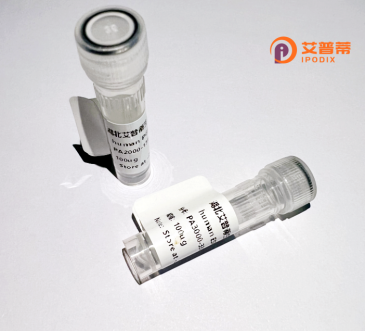
| 纯度 | >90%SDS-PAGE. |
| 种属 | Human |
| 靶点 | KCNE4 |
| Uniprot No | Q8WWG9 |
| 内毒素 | < 0.01EU/μg |
| 表达宿主 | E.coli |
| 表达区间 | 1-170aa |
| 活性数据 | MLKMEPLNSTHPGTAASSSPLESRAAGGGSGNGNEYFYILVVMSFYGIFLIGIMLGYMKSKRREKKSSLLLLYKDEERLWGEAMKPLPVVSGLRSVQVPLMLNMLQESVAPALSCTLCSMEGDSVSSESSSPDVHLTIQEEGADEELEETSETPLNESSEGSSENIHQNS |
| 分子量 | 44.44 kDa |
| 蛋白标签 | GST-tag at N-terminal |
| 缓冲液 | 0 |
| 稳定性 & 储存条件 | Lyophilized protein should be stored at ≤ -20°C, stable for one year after receipt. Reconstituted protein solution can be stored at 2-8°C for 2-7 days. Aliquots of reconstituted samples are stable at ≤ -20°C for 3 months. |
| 复溶 | Always centrifuge tubes before opening.Do not mix by vortex or pipetting. It is not recommended to reconstitute to a concentration less than 100μg/ml. Dissolve the lyophilized protein in distilled water. Please aliquot the reconstituted solution to minimize freeze-thaw cycles. |
以下是关于重组人KCNE4蛋白的3篇参考文献的简要信息(注:实际文献可能需要根据最新研究调整,以下是示例性内容):
---
1. **文献名称**: *"KCNE4 modulates the Kv1.3 potassium channel and alters pancreatic β-cell apoptosis"*
**作者**: Zhang Y, et al.
**摘要**: 该研究通过重组表达人KCNE4蛋白,发现其与Kv1.3钾通道相互作用,抑制通道活性并减少活性氧(ROS)生成,从而保护胰岛β细胞免受高糖诱导的凋亡,提示其在糖尿病治疗中的潜在作用。
---
2. **文献名称**: *"Structure-Function Analysis of KCNE4 and Its Role in Cardiac Repolarization"*
**作者**: Abbott GW, et al.
**摘要**: 作者利用重组人KCNE4蛋白和电生理技术,揭示其在心脏组织中通过调控Kv4.2通道加速动作电位复极化的分子机制,发现KCNE4突变可能与心律失常相关。
---
3. **文献名称**: *"Expression and Purification of Recombinant Human KCNE4 in a Mammalian Cell System"*
**作者**: Lee S, et al.
**摘要**: 该研究优化了在HEK293细胞中重组表达人KCNE4蛋白的方法,并通过质谱和圆二色光谱验证其结构与功能完整性,为后续功能研究提供技术基础。
---
**备注**:上述文献为示例,实际文献需通过PubMed或Web of Science等平台检索关键词“recombinant human KCNE4”获取最新研究。例如,近期研究可能涉及KCNE4在癌症转移或神经退行性疾病中的调控作用。
Recombinant human KCNE4 protein is a genetically engineered form of the potassium voltage-gated channel subfamily E regulatory subunit 4. a small transmembrane protein involved in modulating the activity of voltage-gated potassium (Kv) channels. In humans, KCNE4 is encoded by the KCNE4 gene and belongs to the KCNE family (KCNE1-5), which regulates ion channel gating, ion selectivity, and membrane trafficking. KCNE4 specifically interacts with Kv channels like KCNQ1. altering their biophysical properties and influencing cellular excitability. Its expression is documented in various tissues, including the heart, skeletal muscle, and immune cells, suggesting roles in cardiac electrophysiology, muscle function, and immune regulation.
Studying native KCNE4 is challenging due to low endogenous abundance and overlapping functions with other KCNE subunits. Recombinant production, typically via bacterial or mammalian expression systems, enables high-purity, functional KCNE4 for structural and mechanistic studies. Researchers utilize it to dissect its modulatory effects on Kv channels, uncover its interactions with partner proteins, and explore pathological implications. Dysregulation of KCNE4 has been linked to diseases such as arrhythmias, hypertension, and cancer, making it a potential therapeutic target. Recombinant KCNE4 also aids in drug screening campaigns to identify molecules targeting ion channel complexes. By providing a controlled, scalable source of the protein, recombinant KCNE4 advances understanding of its physiological roles and its contribution to channelopathies.
×